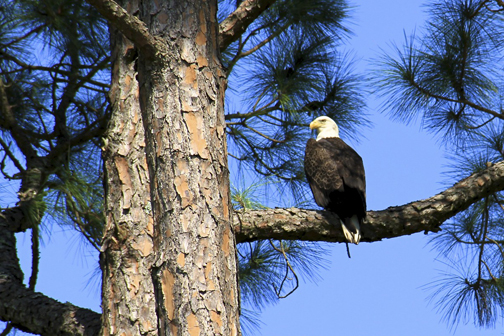
A bird’s eye view
Local golfer Cory Davis captured this great photo of a bald eagle on Oct. 24, 2011. The photo was taken above the 16th hole at Emerald Bay Golf Club in Destin.
A great bonus to the game!
About the Southern baled eagle:
The bald eagle is a success story in the United States, particularly here in
Florida. With more than 2,000 active nests in Florida, the eagles have had a 300 percent increase in population since monitoring began in 1973.
As a result, the bald eagle was removed from the state threatened species list by the Florida Fish and Wildlife Conservation Commission (FWC) in April 2008. The U.S. Fish and Wildlife Service (USFWS) removed the bald eagle from the federal endangered and threatened list in 2007.
Breeding Behavior
• Bald eagles are highly social outside of the nesting season, but are extremely territorial when nesting.
• Bald eagles in Florida begin building a nest or start gathering materials for a nest in late September or early October.
• Bald eagles in Florida strongly prefer living native pines to all other substrates for nesting; 75 percent of all eagle nests surveyed during 2006 were built in living native pines.
• Nearly all bald eagle nests in Florida are built within 1.8 miles of water
• Most clutches of eggs in Florida are laid between December and early January.
Movements
Most of Florida’s breeding bald eagles, especially those nesting in the extreme southern peninsula, remain in the state year-round, but most subadults, or birds not quite fully grown, and non-breeding adults migrate out of Florida.
Food
Bald eagles are opportunistic foragers, feeding or scavenging on a wide variety of prey. Primary prey of eagles in Florida includes various fish and waterfowl species.
Longevity
• The record lifespan for a bald eagle in the wild is 28 years.
Habitat
• Throughout their range, bald eagles use forested habitats for nesting and roosting, and expanses of shallow fresh or salt water for foraging. Nesting habitat generally consists of densely forested areas of mature trees that are isolated from human disturbance.
Information provided by FWC.

Neil Sorrell
October 26, 2011When I go golfing I always like to see eagles—on my score card!